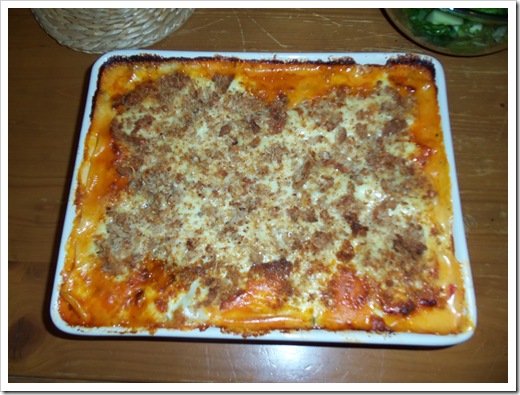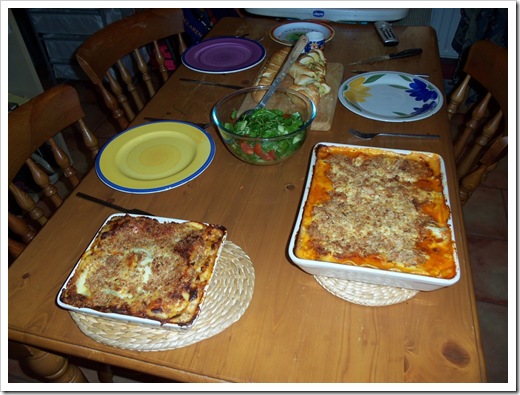Vegetarian Week: Vegetable lasagne recipe
It’s National Vegetarian Week this week and I’m guest-posting over at Plus 2.4, so please go and read about how we deal with having a family with one vegetarian, one omnivore and two haven’t-yet-decided children. There are some handy tips about adapting recipes to cater for the different tastes and preferences. And while you’re there read the rest of her Vegetarian Week posts and recipes. There are some yummy sounding recipes up there already and some food for thought too (sorry, hideously obvious play on words there).
In the meantime, here’s my recipe for Vegetarian Lasagne – plenty of dedicated meat-eaters prefer this to a mince lasagne, though I do have to admit that Rosemary’s still not a big fan, which is a shame as it’s one of my favourite dishes.
Vegetarian lasagne
Preparation time: 45 minutes
Cooking time: 40 minutes
Serves: 6-10, depending on how hungry everyone is
Ingredients
For the tomato and vegetable sauce
Olive oil
3 cloves garlic
1 medium onion
2 medium carrots
2 medium peppers (I prefer red and yellow)
1 large courgette
half tube of tomato purée
1 tin of chopped tomatoes (or tin of plum tomatoes, chopped)
herbs to season (I usually use basil, oregano and tarragon)
For the cheese sauce
100g butter
4 tablespoons plain white flour
1 teaspoon mustard powder
1 teaspoon vegetable bouillon powder
250g extra mature cheddar, grated (set aside two handfuls for topping)
milk (probably around .75 litre)
For the topping
2 slices of stale wholemeal bread
a couple of handfuls of the grated cheese from the cheese sauce
Sheets of lasagne
Method
Finely chop the garlic and finely dice the onion and sauté lightly in the olive oil.
Finely dice the carrots and add, stirring.
Finely dice the peppers, stirring.
Finely dice the courgette stirring.
Note: Even if you finely dice it all in advance, do it in that order and leave some time between each ingredient – it doesn’t taste the same if you just shove it all in together.
Allow the vegetables to cook for a few minutes before adding the tomato purée, tomatoes and herbs. Simmer for 20 minutes or so, adding a little water if it gets a bit too dry.
Meanwhile, make the cheese sauce.
Melt the butter in a largish saucepan (non-stick, ideally) on a high heat.
Mix together the flour, mustard powder and bouillon powder.
When the butter is completely melted, add the flour mixture and stir until you have a roue (thick paste).
Gradually pour in some milk, stirring continuously. The sauce will thicken considerably. Keep adding milk and stirring, until the sauce starts thinning out to the consistency you want (thicker than pancake batter, thinner than cake batter).
Take the pan of the heat. Add the grated cheese and stir until it’s melted in.
Note: It’s essential to take the pan off the heat when you add the cheese, otherwise you lose a lot of the flavour.
Preheat the oven to 200°C.
Layer the sauces and lasagne in a lasagne dish – tomato sauce, lasagne, cheese sauce, lasagne, tomato sauce, lasagne, cheese sauce (or just first three, if your dish isn’t deep enough to do two of each layer).
Mix the breadcrumbs and grated cheese together and sprinkle over the top, covering the cheese sauce.
Cook in the oven for 40 minutes.
Accompaniments
Serve with a salad and garlic bread or roast new potatoes and red wine.
Adaptations
We sometimes make two lasagnes – one vegetarian and one meat. We share the cheese sauce and sometimes make a separate tomato sauce which is split in two and to which we add mince or vegetables. If we do it this way, I usually roast the vegetables for 15 minutes, rather than cooking them as above.
You can vary the vegetable content, according to taste and nutritional requirements – e.g. you could add mushrooms, lentils or beans. A layer of fresh spinach (usually requires two whole bags!), blanched for 2-3 minutes, is very nice.



Leave a Reply